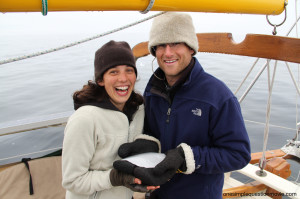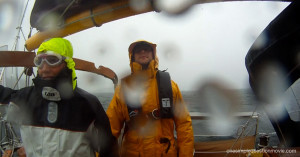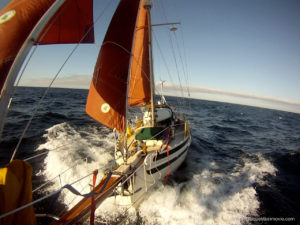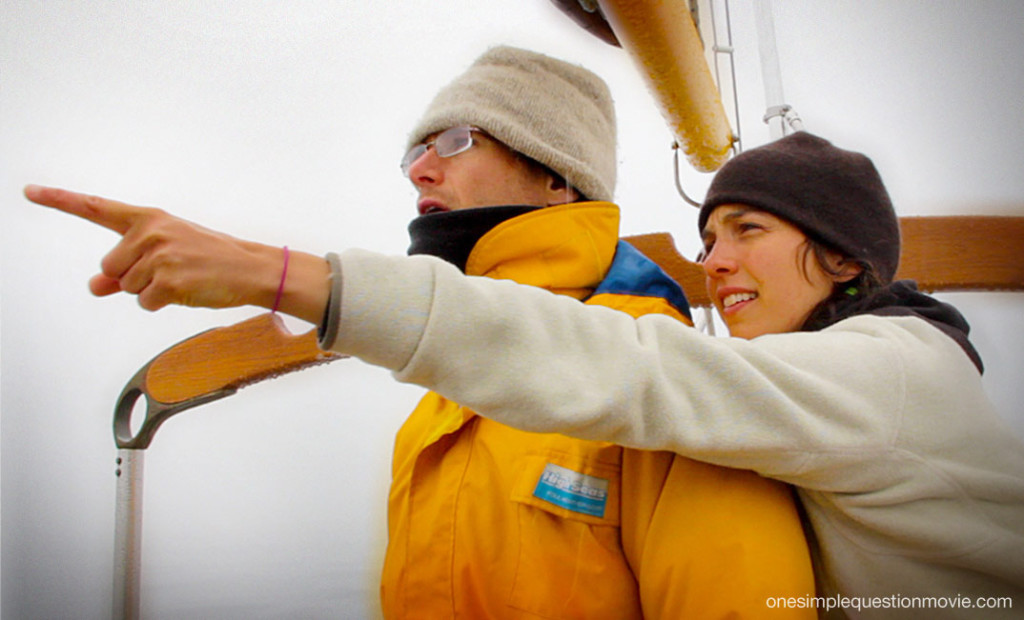Young Explorer Series ~ One Simple Question
March 29, 2013
Last summer Ben and I set out on an ocean voyage once again, but this voyage was a little different for two reasons. Our destination this time was not a specific harbor. It wasn’t even a fixed location. Instead, we were on a quest to see something roving, something that’s location can only be described in one word: North.
 We looked forward to departing Long Island. After all, the water is always bluer on the other side, and Long Island was experiencing a blistering heat wave. I was cranky from the heat and being steeped in my own sweat. On June 8th, replete with all the equipment necessary for making an independent film, a motley crew of four boarded Elizabeth, a 28’ Channel Cutter. Ben and I shared command of the vessel. Dory the cat kept our feet warm at night. Chris, the Director of Photography from Doctrine Creative, had never been sailing before, but his job was to document on film the truth about living aboard, voyaging on a small vessel, and the quest to find an iceberg. None of us could prognosticate what our summer would actually be like, but we were all ready for the adventure of a lifetime.
We looked forward to departing Long Island. After all, the water is always bluer on the other side, and Long Island was experiencing a blistering heat wave. I was cranky from the heat and being steeped in my own sweat. On June 8th, replete with all the equipment necessary for making an independent film, a motley crew of four boarded Elizabeth, a 28’ Channel Cutter. Ben and I shared command of the vessel. Dory the cat kept our feet warm at night. Chris, the Director of Photography from Doctrine Creative, had never been sailing before, but his job was to document on film the truth about living aboard, voyaging on a small vessel, and the quest to find an iceberg. None of us could prognosticate what our summer would actually be like, but we were all ready for the adventure of a lifetime.
We waved goodbye to Huntington Harbor around noon and during that first night sailed right into the heart of a cold front with unfettered lightning striking everywhere around us. With each intense burst of light and sound, visions of disaster reverberated in my mind. All of us, huddled together in the cockpit, discussed the location of fire extinguishers, the dinghy launching procedure and the likely results of a direct strike, feeling that at any moment we could be dealing with a complete loss of electrical systems, a fire, or even an abandon ship situation. The second night seemed tame by comparison — a squall producing a sustained fifty knots of wind, with even stronger gusts. The third night, a calm but cold rain set in, and from the next day on, the wind was on our nose and the cold was biting our skin. In stark contrast to just a few days before, we were all interminably wet and cold and longed for even just one day when the wintry weather would give way to summer. But it never did, the cold persevered, and we settled into a routine that included frequent hot beverages and belly warming comfort foods.
 Ben and I maintained a watch rotation schedule of three hours on, three hours off throughout the day and night while underway. Chris didn’t stand a watch, but was awake at various times during both night and day to film the events of the moment or to share a meal together. When we weren’t standing watch, filming, eating, or using the head, we were curled up under as many blankets as we could keep piled on top of our slippery sleeping bags.
Ben and I maintained a watch rotation schedule of three hours on, three hours off throughout the day and night while underway. Chris didn’t stand a watch, but was awake at various times during both night and day to film the events of the moment or to share a meal together. When we weren’t standing watch, filming, eating, or using the head, we were curled up under as many blankets as we could keep piled on top of our slippery sleeping bags.
Contrary to our expectations of warm and favorable summertime South Westerlies, most of what we saw were cold, clammy North Easterlies — right on the nose. Front after front crossed the Canadian maritimes, passing from West to East, intersecting our path with regularity. As we charged through relentless wind and waves, we questioned our sanity and asked ourselves, “Is this really worth it?” Doubt about seeing the icebergs filled our minds during watch, as we tried to keep Elizabeth moving at best possible speed. Iceberg season peaks in early May, and this was mid June already. Time was also against us. But, despite our doubts, our commitment to the quest carried us onward.
 As we made progress North, the water temperature dropped a few degrees each day, until it finally dipped below the freezing point — a chilly thirty-one degrees. The west coast of Newfoundland is a long coastline of tall, jagged rock cliffs, and mountains with very few harbors. The Strait of Belle Isle, the narrow body of water between Newfoundland and Labrador, is feeding ground for Humpback and Wright Whales. The abundant marine mammal population kept us company on lonely night watches with their familiar and comforting exhales…and maybe we kept them company too. On day 20, which was a typically brisk and gusty day, under double reefed main and stays’l, we rounded the northern tip of Newfoundland, eased sheets and made way for St. Anthony, the ‘big city’ of northern Newfoundland.
As we made progress North, the water temperature dropped a few degrees each day, until it finally dipped below the freezing point — a chilly thirty-one degrees. The west coast of Newfoundland is a long coastline of tall, jagged rock cliffs, and mountains with very few harbors. The Strait of Belle Isle, the narrow body of water between Newfoundland and Labrador, is feeding ground for Humpback and Wright Whales. The abundant marine mammal population kept us company on lonely night watches with their familiar and comforting exhales…and maybe we kept them company too. On day 20, which was a typically brisk and gusty day, under double reefed main and stays’l, we rounded the northern tip of Newfoundland, eased sheets and made way for St. Anthony, the ‘big city’ of northern Newfoundland.
2010 was one of the worst years on record for the iceberg tourism industry, and this year wasn’t showing much promise of improvement. In St. Anthony we asked some fishermen, who had just returned from a few days out trawling for shrimp, where we might find some ‘bergs’. In thick ‘Newfie’ brogue, they asked us ‘why would you want to do that, we try to avoid them!’ Then went on to tell us of a huge iceberg that was flowing south in the Labrador Current, and wasn’t more than a few days North of St. Anthony. This report was confirmed in the next days’ newspaper, with a front page article featuring a photo showing this ‘once in a lifetime sized’ iceberg. This particular iceberg was part of the Petermann Ice Island, the largest chunk of Greenland glacier to break off in 60 years, and it was headed right for us.
With the adrenaline flowing we spent the next day we preparing for the arrival of this giant iceberg. We charged the batteries to our cameras, cleared our SD cards, watched the weather and news reports to learn all we could about this massive chunk of ice. The papers claimed it was longer than several football fields, and stood over 5 stories tall. Scientists claimed that this iceberg significantly disrupted the mass-balance of Greenland. It would take three decades to replenish that amount of ice. We were eager to see it and witness the effects of climate change right before our eyes.
 We hauled anchor at 0830 the next morning with surprisingly clear skies above us. We could almost make out the shape of the sun! Upon clearing the rocky entrance to the harbor we immediately saw on the distant horizon a gleaming white chunk emerging majestically from the ocean. The weeks of rain, cold, and head-winds were immediately forgotten. Jumping up and down while hugging one another and cheering like we’d just won the lottery, we pointed the bow toward ‘our elusive iceberg’ and set full sail. It felt strange to be celebrating something that represented a change in our formerly stable climate. It could be a change for the worse. But we were celebrating a journey, a discovery, and an opportunity to witness something that is both beautiful and fragile in nature.
We hauled anchor at 0830 the next morning with surprisingly clear skies above us. We could almost make out the shape of the sun! Upon clearing the rocky entrance to the harbor we immediately saw on the distant horizon a gleaming white chunk emerging majestically from the ocean. The weeks of rain, cold, and head-winds were immediately forgotten. Jumping up and down while hugging one another and cheering like we’d just won the lottery, we pointed the bow toward ‘our elusive iceberg’ and set full sail. It felt strange to be celebrating something that represented a change in our formerly stable climate. It could be a change for the worse. But we were celebrating a journey, a discovery, and an opportunity to witness something that is both beautiful and fragile in nature.
As we approached, we realized there were actually two icebergs. One was tabular, meaning flat on top and extending in a straight column down into the sea. This one we later learned, was so deep that it had ‘grounded-out’ on the sea floor in over 350′ of water, for what turned out to be a few weeks. The second one peaked on top, like a little snow-capped mountain. The ice was more blue than white, arranged in stratified colorful layers. It was glassy-hard in some places and snowy-soft in others. Surrounding the ice was a community of birds and seals that followed along as the ice drifted south. On top of one iceberg rested a pond with its own ecosystem and wildlife. The other berg featured a waterfall, pouring water over its edge and plunging loudly into the ocean.
Ben and I collected a little bergy bit, heated it in a saucepan, and tasted it, “not even slightly salty” Ben noted whimsically. Several fishing boats surrounded the icebergs, harvesting the larger chunks that had broken off. They bottle and sell this iceberg water as drinking water or use in the manufacturing of Iceberg Vodka. Iceberg water is the purest water on the planet. It was formed long ago, before humans built cities and machines that polluted the air and soil. This pure ancient water, had been preserved in the northern glaciers for thousands of years but now as a result of climate change, is moving slowly south, melting away and assimilating with the rest of the world’s water supply.
What a priceless experience it is to see a piece of ancient history floating by, and to experience so close, the simple beauty of nature. We came a long way, through some of the most challenging sailing I have experienced. Unbearable cold, fifty knots of wind, storms, exhausting watches, all the while questioning our own goal. But as I watched the tour boats, with their guides pointing out the puffins, whales, and bergs, and tourists dressed comfortably in warm clothing and disposable ponchos, I came to understand that the payoff of seeing this natural wonder would not be worth even half as much without the journey.
By Teresa Carey and Ben Eriksen
Photography: Chris Rodriguez, Doctrine Creative
Find out more at Simplequestionmovie.com








